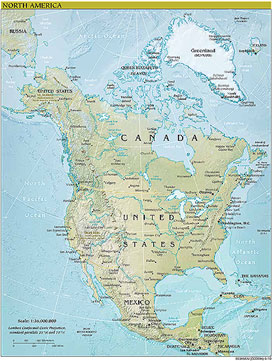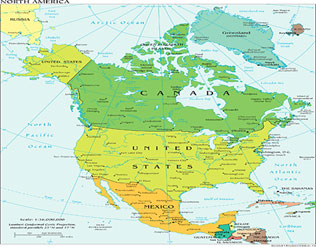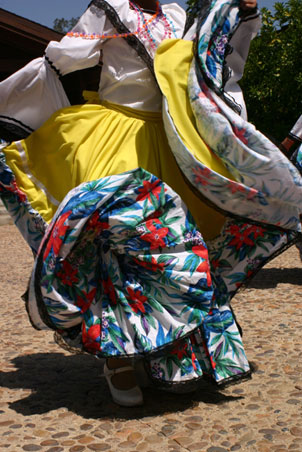
In this section, you will learn the different characteristics that make up North America and Latin America. You will discover the elements that set the regions apart and the ones that bind them. It is important to note that these regions overlap.

Lying within the northern and western hemispheres, North America is the world’s third largest continent. North America includes 23 countries, islands, and territories. North America also encompasses Central America and the islands of the Caribbean. Greenland, the world’s largest continent, is also a part of North America. Within the borders of North America is one of the most diverse countries in the world, the United States. North America is also home to the largest free trade area in the world organized under NAFTA, the North American Free Trade Agreement. It is this nature of diversity and cooperation that make this region one of the most unique in the world.
![]() Take a look at the photo below. Can you identify the men in this image? Click on each person to compare your answers.
Take a look at the photo below. Can you identify the men in this image? Click on each person to compare your answers.
This image is of the leaders of the three major countries of North America: the United States, Canada, and Mexico. The photo was taken at a press conference at The White House in 2012. The leaders were discussing ways to increase economic growth in North America. As the key countries of North America, cooperation between them is imperative to the success of all three countries. NAFTA, the North Atlantic Free Trade Agreement, is an example of such cooperation. This agreement, ratified in 1993, created the largest free trade area in the world.

Think about this - Why is an agreement of economic cooperation, such as NAFTA, between the three major countries of North America important to these countries? Record your thoughts in your notes and thenInteractive popup. Assistance may be required.
An agreement like NAFTA is important so that neighboring countries can work together on economic issues and build better relationships.
![]() Click on each of the following four characteristics to learn more about the region’s religions, languages, literacy rate, and land use.
Click on each of the following four characteristics to learn more about the region’s religions, languages, literacy rate, and land use.

Compare the North America land use map (in the triangle) to the North America physical map (pictured above) and answer the following questions using your notes.
Interactive popup. Assistance may be required.
Minerals are found along the mountain ranges that connect the three countries.
Interactive popup. Assistance may be required.
Forest products are found primarily in Canada.
Interactive popup. Assistance may be required.
Puerto Rico, located in the Caribbean, has commercial agriculture and manufacturing and trade centers.
Diversity is the main characteristic of North America’s culture. A history of immigration to the United States, coupled with the increased Mexican migration to both the United States and Canada after NAFTA, has added to the North American culture. Many of the traditions and customs stem from the various religions that contribute to the cultural landscape observed through holidays or celebrations; holidays such as Christmas are observed throughout North America.

Observances of other major events, such as Independence Day, Canada Day, and Cinco de Mayo, reflect the history of the countries in North America. The United States celebrates July 4th as its Independence Day, the day it gained its independence from Great Britain. In Canada, the uniting of its provinces is celebrated on July 1st, also known as Canada Day. Mexico celebrates May 5th, commonly known as Cinco de Mayo, as an observance of the Mexican army victory at the Battle of Puebla.
Cinco de Mayo is often celebrated in various regions in the southwestern region of the United States as a result of the relationship with Mexico.
Sources for images used in this section, as they appear, from top to bottom: